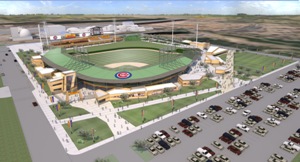Groundbreaking Date Set for Chicago Cubs Spring Training Stadium
The City of Mesa and Chicago Cubs this week announced plans to break ground on their new spring training baseball facility on July 11. The stadium will become the western headquarters for the Chicago Cubs. In addition, the City and Cubs are in final stages of an agreement that will make the complex the new home for the Arizona State University baseball program.


Located at the intersection of the Loop 101 and 202 freeways in Mesa, the project was approved by Mesa voters in 2010. With capacity for 15,000 attendees, the stadium includes shaded seats , luxury suites, a video board and concessions. New design renderings released this week revealed a stadium that will incorporate some of the unique features of Wrigley Field as well as distinctive aspects from the Arizona area.
Design and construction is estimated at $84 million, with an additional $15 million for roadways, utilities and parking.
The new complex will include a shared playing field, seven full-size practice fields and one infield-only natural turf practice field. There will also be a separate clubhouse for ASU, and one of the practice fields will be solely devoted to ASU usage.
“Arizona State has an innovative and unique opportunity to align with one of the world’s most recognizable sports brands in the Chicago Cubs, while also increasing the university’s reach by enhancing its presence in both the city of Mesa and Illinois,” says Steve Patterson, ASU vice president for University Athletics and athletics director, in a statement.
Populous, Kansas City, Mo., is designing the facility, with the assistance of several local firms, including DWL Architects, EPS Group Inc., Greey Pickett and Saemisch DiBella Architects. Hunt Construction Group, Scottsdale, Ariz., is the general contractor under a construction manager-at-risk contract.
The Cubs have practiced in Mesa for more than 45 years. With the expanding popularity of Arizona’s Cactus League, the Cubs felt that Hohokam Park was no longer adequate. The new facility will keep the team in Arizona for at least the next 30 years.



